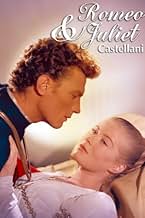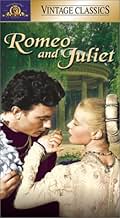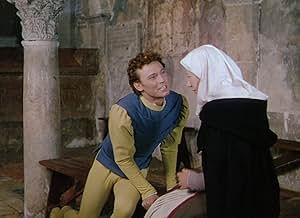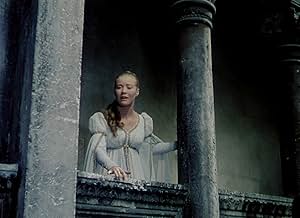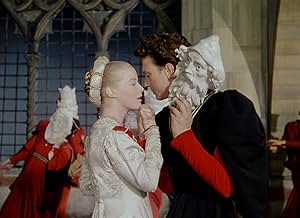IMDb RATING
6.0/10
670
YOUR RATING
In Shakespeare's classic play, the Montagues and Capulets, two families of Renaissance Italy, have hated each other for years, but the son of one family and the daughter of the other fall de... Read allIn Shakespeare's classic play, the Montagues and Capulets, two families of Renaissance Italy, have hated each other for years, but the son of one family and the daughter of the other fall desperately in love and secretly marry.In Shakespeare's classic play, the Montagues and Capulets, two families of Renaissance Italy, have hated each other for years, but the son of one family and the daughter of the other fall desperately in love and secretly marry.
- Director
- Writers
- Stars
- Nominated for 3 BAFTA Awards
- 6 wins & 6 nominations total
Ennio Flaiano
- Prince of Verona
- (as Giovanni Rota)
Thomas Nicholls
- Brother Giovanni
- (as Tom Nicholls)
- Director
- Writers
- All cast & crew
- Production, box office & more at IMDbPro
Featured reviews
This film version created by Renato Castellani is a beauty to behold.
In the picturesque settings of Siena, Padova, Verona and Venice, this romantic tale unfolds in glorious color.
While the character interpretations may appeal to a select number, I appreciate the total concept and the carrying out of that objective.
"Romeo" takes on a stylistic life of its own through Castellani, and for those willing to go on his journey, the rewards are great.
Mr. Harvey is interesting to see in an early role. As always, his work is very well thought out, and the aloofness which made him so right for callous young men in later modern roles, is intriguing here. Romeo now has a tinge of egotism and even femininity.
Well, why not? As there are dozens of ways to read a line, so there are many approaches to a character. There's nothing inherently sacrosanct in the role of Romeo, and Harvey interprets the way he (and Castellani) sees him, rather than according to some staid traditional model.
It's hard to believe this lovely production has not yet been transferred to video. Surely one day some enterprising company will take on this project and help preserve a very beautiful production for future generations to enjoy.
In the picturesque settings of Siena, Padova, Verona and Venice, this romantic tale unfolds in glorious color.
While the character interpretations may appeal to a select number, I appreciate the total concept and the carrying out of that objective.
"Romeo" takes on a stylistic life of its own through Castellani, and for those willing to go on his journey, the rewards are great.
Mr. Harvey is interesting to see in an early role. As always, his work is very well thought out, and the aloofness which made him so right for callous young men in later modern roles, is intriguing here. Romeo now has a tinge of egotism and even femininity.
Well, why not? As there are dozens of ways to read a line, so there are many approaches to a character. There's nothing inherently sacrosanct in the role of Romeo, and Harvey interprets the way he (and Castellani) sees him, rather than according to some staid traditional model.
It's hard to believe this lovely production has not yet been transferred to video. Surely one day some enterprising company will take on this project and help preserve a very beautiful production for future generations to enjoy.
10fjoffily
Castellani presents his neo-realistic view of WS's tragedy. Never have the personalities of the two lovers been so intensely portrayed in the screen. Susan Shentall conveys all the fire of the first love and the impending tragedy that will follow it. Laurence Harvey, though not the ideal match (as far as age is concerned) for Shentall's Juliet, manages to pass Romeo's brash, passioned nature. The great Robert Krasker's photography is the work of a consummated master: each picture frame reflects a Renaisssance painting, as well as the sets (all original ones in Venice, Padova, Verona and Siena), costumes and the décor. The best names then available in those fields in Europe were recruited to recreate what Romeo and Juliet's Verona should have been. The result is a joy to watch and is worth the movie. The ball scene alone could receive all the prizes this film was awarded in the 1954 Venice Film Festival. Roman Vlad's use of an Italian medieval gagliarda as the film's dominating musical comment is a lesson in itself. When compared to Castellani's masterpiece, all other versions seem like pale, unfocused, poor readings of WS's immortal tragedy. Hope this film will soon be available on DVD.
The Blu-Ray version of the Castellani "Romeo and Juliet": this is one of the greatest movies of all time. Castellani was surely not a Visconti nor a Rosselini, but his "Romeo and Juliet" is absolute perfection. However, this Blu-Ray incarnation is a disaster. The glorious cinematography (Robert Krasker) is disgraced by a white-washed remastering. The ball scene is completely distorted. The colours that were once a magnificent succession of Renaissance paintings now appear irritatingly blurred. And - alas ! - there is more: subtitles are frequently a gross distortion of the original text - e.g.: in the DVD version the master of ceremonies at the Capulet's ball announces that "... the musicians of Saint Jerome will now play..." In the Blu-ray captions read ..."the musicians of CENTER ROME will now play...". Ghastly. Also, many dialogues are not transcribed, and one frequently bumps into an "a" or a "the" in capital letters in the middle of a sentence. The whole transcription is absolutely amateurish. Therefore, keep your precious DVD of this masterwork and forget this third-rate Blu-Ray.
The Blu-Ray version of the Castellani "Romeo and Juliet": this is one of the greatest movies of all time. Castellani was surely not a Visconti nor a Rosselini, but his "Romeo and Juliet" is absolute perfection. However, this Blu-Ray incarnation is a disaster. The glorious cinematography (Robert Krasker) is disgraced by a white-washed remastering. The ball scene is completely distorted. The colours that were once a magnificent succession of Renaissance paintings now appear irritatingly blurred. And - alas ! - there is more: subtitles are frequently a gross distortion of the original text - e.g.: in the DVD version the master of ceremonies at the Capulet's ball announces that "... the musicians of Saint Jerome will now play..." In the Blu-ray captions read ..."the musicians of CENTER ROME will now play...". Ghastly. Also, many dialogues are not transcribed, and one frequently bumps into an "a" or a "the" in capital letters in the middle of a sentence. The whole transcription is absolutely amateurish. Therefore, keep your precious DVD of this masterwork and forget this third-rate Blu-Ray.
Even though the colour and the impressive location scenarios work really well here, the rest of it rather falls between two stools. It lacks the intensity of a stage play and the acting talent assembled - Flora Robson and the underused John Gielgud notwithstanding - is really quite underwhelming. You'll recall the story of the feuding Montagues and Capulets that sees true love emerge from centuries of slaughter and mayhem. It's "Romeo" (Laurence Harvey) who falls for "Juliet" (Susan Shentall) and they must keep their burgeoning romance under wraps for fear of all hell breaking loose. That's becoming harder and harder but as the story unfolds it also becomes much less engaging to watch. Harvey never was a particularly versatile actor and there's virtually no chemistry on display between him and the almost as wooden though maybe a bit more suitably virtuous Shentall. It's very much a lacklustre ensemble effort with few of the originally quirky and notable characters standing up to much scrutiny and somehow Renato Castellani has striven to create something here that belies it's credentials as one of literature's greatest and most enduring love stories. At times, it is almost little better than a very well choreographed and photographed soap. Every now and again these re-imaginings of Shakespeare's works come along, but this one is unlikely to be one anyone remembers too fondly.
Renato Castellani's ROMEO AND JULIET has somehow fallen into a hole in film history. Despite a handsome production with some worthy performances, it is overshadowed by Franco Zefferelli's 1966 film and even the 1936 MGM movie with Norma Shearer, Leslie Howard, Basil Rathbone, and John Barrymore. One has to wonder why - it was the first version of the movie to be shot (or partially shot) on locale in Italy in color. While the leads are not the proper juveniles that appeared in the 1966 version, Lawrence Harvey and Susan Shentell were closer to the ages of the characters than Howard and Shearer were.
My guess is that it's very reliance on Italian movie production may have been a drawback to the audiences who (unfortunately) counted the most: English - speaking ones. The leads were all English and the basic play (despite the Italian setting) was in English by the greatest writer of the English language. If it had been filmed in England I suspect it would have had more acceptance. But this is a guess. There could have been other factors: bad timing due to more overpowering productions. Orson Welles' had completed and released OTHELLO in 1952 (where it, like this ROMEO AND JULIET, won a prize at the Venice Film Festival). The following year Lawrence Olivier's masterly RICHARD III was released. The failure of the Castellani movie remains striking and puzzling.
Today Zefferelli's version is considered the best one by most viewers, because of his making his hero and heroine what they are: growing teenagers. But one should not sneer at Harvey's attempts at Romeo opposite Shentell's Juliet. They do generate a soft glow between them that gradually picks up heat. I might add that I found Shentell's final suicide rather stark and complete as it should be. Whether due to her acting or the director's direction she gave Juliet's passing a type of dignity I have rarely seen.
As for the performers in the cast, Sebastian Cabot's Capulet is the picture of an Italian Renaissance merchant prince type, corpulent and ruthless towards his family's foes. It's funny thinking of Cabot today as a villain in his roles, but in fact (prior to his going into CHECKMATE on television - where he was the wise spy master of the heroes) most of his film parts were villainous, or (as in THE TIME MACHINE) ridiculously self-important. His belated affability appeared only when he lucked out and became "Mr. French" in FAMILY AFFAIR. So here, a 1954 audience in the know, would have had no problem about his rattlesnake - eyed timing in planning the demise of Montagues. Look at his scene at the ball he is throwing when Tybalt (Enzo Fiormonte) wants to kill Romeo, but Cabot restrains him - adding that it can be done later.
Also note Mervyn Johns as Friar Lawrence, who manages to show the all-to-human side of the good man, which enables so many bad things to occur because of his trusting the wrong people (one messenger is locked up because he is stuck in a quarantined house), or his instructions were not clear enough. Johns was a gifted actor in his own way. Most people remember him as gentle, loving Bob Crachit opposite crusty, nasty Scrooge (Alistair Sim). But he was also the bedeviled and doomed architect in DEAD OF NIGHT, and the equally doomed partner of the ruthless Spencer Tracy in EDWARD MY SON. Johns was a fine character role player, and was lucky to pass on his skills to his daughter Glynnis.
My guess is that it's very reliance on Italian movie production may have been a drawback to the audiences who (unfortunately) counted the most: English - speaking ones. The leads were all English and the basic play (despite the Italian setting) was in English by the greatest writer of the English language. If it had been filmed in England I suspect it would have had more acceptance. But this is a guess. There could have been other factors: bad timing due to more overpowering productions. Orson Welles' had completed and released OTHELLO in 1952 (where it, like this ROMEO AND JULIET, won a prize at the Venice Film Festival). The following year Lawrence Olivier's masterly RICHARD III was released. The failure of the Castellani movie remains striking and puzzling.
Today Zefferelli's version is considered the best one by most viewers, because of his making his hero and heroine what they are: growing teenagers. But one should not sneer at Harvey's attempts at Romeo opposite Shentell's Juliet. They do generate a soft glow between them that gradually picks up heat. I might add that I found Shentell's final suicide rather stark and complete as it should be. Whether due to her acting or the director's direction she gave Juliet's passing a type of dignity I have rarely seen.
As for the performers in the cast, Sebastian Cabot's Capulet is the picture of an Italian Renaissance merchant prince type, corpulent and ruthless towards his family's foes. It's funny thinking of Cabot today as a villain in his roles, but in fact (prior to his going into CHECKMATE on television - where he was the wise spy master of the heroes) most of his film parts were villainous, or (as in THE TIME MACHINE) ridiculously self-important. His belated affability appeared only when he lucked out and became "Mr. French" in FAMILY AFFAIR. So here, a 1954 audience in the know, would have had no problem about his rattlesnake - eyed timing in planning the demise of Montagues. Look at his scene at the ball he is throwing when Tybalt (Enzo Fiormonte) wants to kill Romeo, but Cabot restrains him - adding that it can be done later.
Also note Mervyn Johns as Friar Lawrence, who manages to show the all-to-human side of the good man, which enables so many bad things to occur because of his trusting the wrong people (one messenger is locked up because he is stuck in a quarantined house), or his instructions were not clear enough. Johns was a gifted actor in his own way. Most people remember him as gentle, loving Bob Crachit opposite crusty, nasty Scrooge (Alistair Sim). But he was also the bedeviled and doomed architect in DEAD OF NIGHT, and the equally doomed partner of the ruthless Spencer Tracy in EDWARD MY SON. Johns was a fine character role player, and was lucky to pass on his skills to his daughter Glynnis.
Handsome, leisurely-paced, ineptly cut, often badly acted (especially by Laurence Harvey as Romeo, surprisingly) version of Shakespeare's most playful and youthful tragedy. Much of the film's charm lies in the creation of sumptuous tableaux in the tradition of Italian Renaissance painting, and the portrayal of Capulet is a marvelously acted stereotype of the fat, crude nouveau riche Italian patriarch; but Harvey (despite a few promising moments early on) is far too effusive and unctuous, creepily reminiscent of John Dall in Rope; Susan Shentall displays admirable coyness and gusto in the "overture" of the dance and courtship scenes, but stiffens and is stifled by the death of a thousand cuts toward the end (although almost nothing is cut from the first act). Still, aside from some ghastly, somnambulistic line readings, the film often dazzles with its feeling for the music of Shakespeare's text; the Nurse's folkloric shanty is highlighted with musical settings (shadings)-- Flora Robson is delightful in the role; the vaguely rappish banter of Benvolio and Romeo's first scene is gracefully and intelligently played. The presentation of the episode of losing the letter due to the Plague is a brilliant use of cinema to bring out embedded narrative in Shakespeare. The near-interchangeability of the actors who play Benvolio, Tybalt and Paris is regrettable.
Did you know
- TriviaDame Joan Collins was originally slated to play Juliet, but turned it down when Writer and Director Renato Castellani insisted she undergo surgery to change the shape of her nose.
- ConnectionsReferenced in Arena: All the World's a Screen - Shakespeare on Film (2016)
- How long is Romeo and Juliet?Powered by Alexa
Details
- Release date
- Countries of origin
- Official site
- Languages
- Also known as
- Romeo and Juliet
- Filming locations
- Italy(made in Italy)
- Production companies
- See more company credits at IMDbPro
- Runtime2 hours 21 minutes
Contribute to this page
Suggest an edit or add missing content


